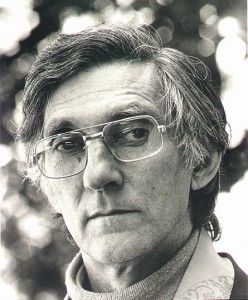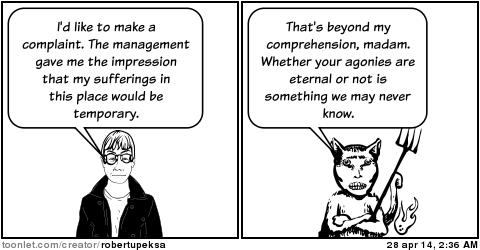This is a re-blog (with a few minor improvements) of a post on my old Middle Way Philosophy blog in September 2012.
Let’s start with a compilation of evil laughs. You’ll probably only need to watch the first minute or so to get the point. What I’d like you to note is certain features of what we imagine to be evil. Note the falseness, the association with a separate universe constructed in one’s own mind, the alienation from others, and the group mentality. All of these are part of our experience of ‘evil’ – but they are not an indication of a supernatural force. Rather they are the features of metaphysics: of fixed beliefs and goals in a super-dominant left brain.
Some people see evil as a supernatural force, whilst others deny its existence or seek to ignore it. I want to avoid either of these approaches and to account for evil, with all its power, in human experience. Just as God can be supremely meaningful without being an object of belief so can evil. The meaning and seriousness of evil seems to be undermined and trivialised in modern culture (illustrated most strongly by the slang use of the terms ‘wicked’ and ‘evil’ to mean conventionally good), but at the same time it is easy to see why this has happened. It demands an absurd level of fraught anxiety to regard ordinary human desire as the work of Satan, when our experience of desire is that it is largely both unavoidable and – up to a point – beneficial. If we have let go of that anxiety and accepted our desires as human, then that is a starting point, but we then need to start taking seriously the need for moral awareness and moral effort. We can only do that with an awareness of what we are avoiding – of ‘evil’ in a broad sense, neither supernatural nor naturalised into nothing.
So what is evil, if it is not Satan outside us, or human desires within us? My thesis is that evil is not a person or a set of feelings or desires, but a type of belief: that is, metaphysics. The integration model explains how we do not have ‘good’ desires and ‘evil’ desires, but rather desires that can be more or less effective as they get more or less integrated. Desires that I may experience as ‘evil’ (say, the desire to be insulting in an argument) are just unintegrated: they are in conflict with my other desires. However, if I then ask what prevents the integration of ‘evil’ (i.e. currently rejected) desires with ‘good’ (i.e. currently accepted) desires, the answer is fixed beliefs. Those beliefs may, on the surface, be about ‘good’ or ‘evil’, but they rigidify and simplify what I understand as good so I can idealise and hold onto it regardless of challenges, and rigidify and simplify what I understand as evil so that I can reject it, regardless of what it may have to tell me. My thesis is that such rigidification tends to occur around metaphysical beliefs – i.e. ones that cannot be incrementally addressed in experience but merely asserted or denied.
So, what is evil, in the broader and more helpful sense, includes metaphysical beliefs about good as well as metaphysical beliefs about evil – along with other metaphysical beliefs such as those about self, fate, freewill, God or nature. It may run against the mental habits of a lifetime to start thinking about the belief in an ultimate good as evil: but we only have to consider the amount of alienation and conflict created by sincerely held ideas of ultimate good to begin to appreciate why this is so. This doesn’t imply that those who hold such beliefs are ‘evil’ or even that they are mainly motivated by evil: only that the impact of such metaphysical beliefs on them is evil, within the context of wider moral development gained by experience. Great saints and religious leaders with strong metaphysical beliefs may often have had a largely good impact – but my thesis is that they were handicapped, not aided, by those beliefs. Their moral objectivity came not from those beliefs, but from the degree of integration created by the other conditions working in their lives, often including the meaningfulness of the symbols (such as God) that they also had metaphysical beliefs about. Similarly, great figures widely regarded as evil (such as Hitler) had a variety of conditions working on them. They were not evil as people, but their rigid metaphysical beliefs dominated their lives to such an extent that their actions strike others as evil. In the case of Hitler it is not only Nazi ideology, but also his beliefs about himself and about the destiny of himself and the Germans, that could be identified as the metaphysical source of this evil.
But what does this have to do with Satan or with evil as traditionally conceived? The picture here, in Jungian terminology, is a picture of the Shadow: the rejected energies in ourselves that we project outwards onto Dark Lords, villains, evil spirits, unfaithful spouses, bad bosses, evil capitalists etc. The features we normally give to ‘evil’ are associated with narrow left-brain dominance rather than with integration: empire-building, scheming, ruthlessness, and false emotion (as in the evil laughs above). Psychologically, then, it appears that what evil means to us is unintegrated desire.
We allow evil itself to dominate, however, if we project that unintegrated desire outwards and treat people or things as themselves evil. An appreciation of complexity, or of humanity, is an antidote to this. We also allow evil to dominate if we even treat our desires themselves as evil – for they are part of us. Evil instead works primarily at the level of belief. It is the belief in the ultimate truth and completeness of his schemes, and the ultimate justification of his ruthlessness through the idealisation of current egoistic desires, that makes the Dark Lord evil.
Devil picture by Rex Diablo (Wikimedia Commons). Picture can be freely reproduced under Creative Commons licence if attributed


